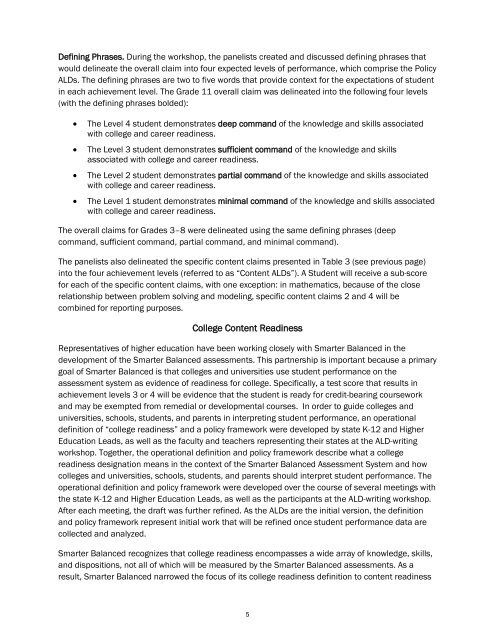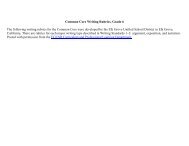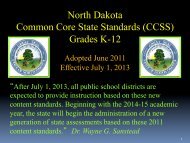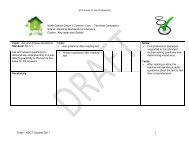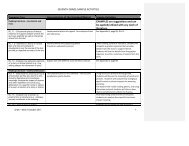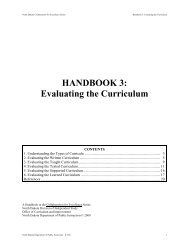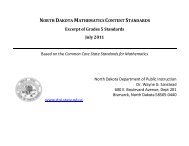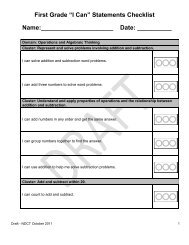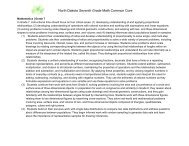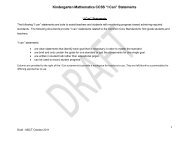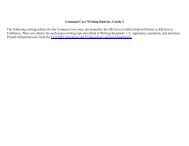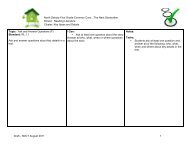SBAC Achievement Level Descriptors, Grade 4 - ND Curriculum ...
SBAC Achievement Level Descriptors, Grade 4 - ND Curriculum ...
SBAC Achievement Level Descriptors, Grade 4 - ND Curriculum ...
Create successful ePaper yourself
Turn your PDF publications into a flip-book with our unique Google optimized e-Paper software.
Defining Phrases. During the workshop, the panelists created and discussed defining phrases thatwould delineate the overall claim into four expected levels of performance, which comprise the PolicyALDs. The defining phrases are two to five words that provide context for the expectations of studentin each achievement level. The <strong>Grade</strong> 11 overall claim was delineated into the following four levels(with the defining phrases bolded):• The <strong>Level</strong> 4 student demonstrates deep command of the knowledge and skills associatedwith college and career readiness.• The <strong>Level</strong> 3 student demonstrates sufficient command of the knowledge and skillsassociated with college and career readiness.• The <strong>Level</strong> 2 student demonstrates partial command of the knowledge and skills associatedwith college and career readiness.• The <strong>Level</strong> 1 student demonstrates minimal command of the knowledge and skills associatedwith college and career readiness.The overall claims for <strong>Grade</strong>s 3–8 were delineated using the same defining phrases (deepcommand, sufficient command, partial command, and minimal command).The panelists also delineated the specific content claims presented in Table 3 (see previous page)into the four achievement levels (referred to as “Content ALDs”). A Student will receive a sub-scorefor each of the specific content claims, with one exception: in mathematics, because of the closerelationship between problem solving and modeling, specific content claims 2 and 4 will becombined for reporting purposes.College Content ReadinessRepresentatives of higher education have been working closely with Smarter Balanced in thedevelopment of the Smarter Balanced assessments. This partnership is important because a primarygoal of Smarter Balanced is that colleges and universities use student performance on theassessment system as evidence of readiness for college. Specifically, a test score that results inachievement levels 3 or 4 will be evidence that the student is ready for credit-bearing courseworkand may be exempted from remedial or developmental courses. In order to guide colleges anduniversities, schools, students, and parents in interpreting student performance, an operationaldefinition of “college readiness” and a policy framework were developed by state K-12 and HigherEducation Leads, as well as the faculty and teachers representing their states at the ALD-writingworkshop. Together, the operational definition and policy framework describe what a collegereadiness designation means in the context of the Smarter Balanced Assessment System and howcolleges and universities, schools, students, and parents should interpret student performance. Theoperational definition and policy framework were developed over the course of several meetings withthe state K-12 and Higher Education Leads, as well as the participants at the ALD-writing workshop.After each meeting, the draft was further refined. As the ALDs are the initial version, the definitionand policy framework represent initial work that will be refined once student performance data arecollected and analyzed.Smarter Balanced recognizes that college readiness encompasses a wide array of knowledge, skills,and dispositions, not all of which will be measured by the Smarter Balanced assessments. As aresult, Smarter Balanced narrowed the focus of its college readiness definition to content readiness5


